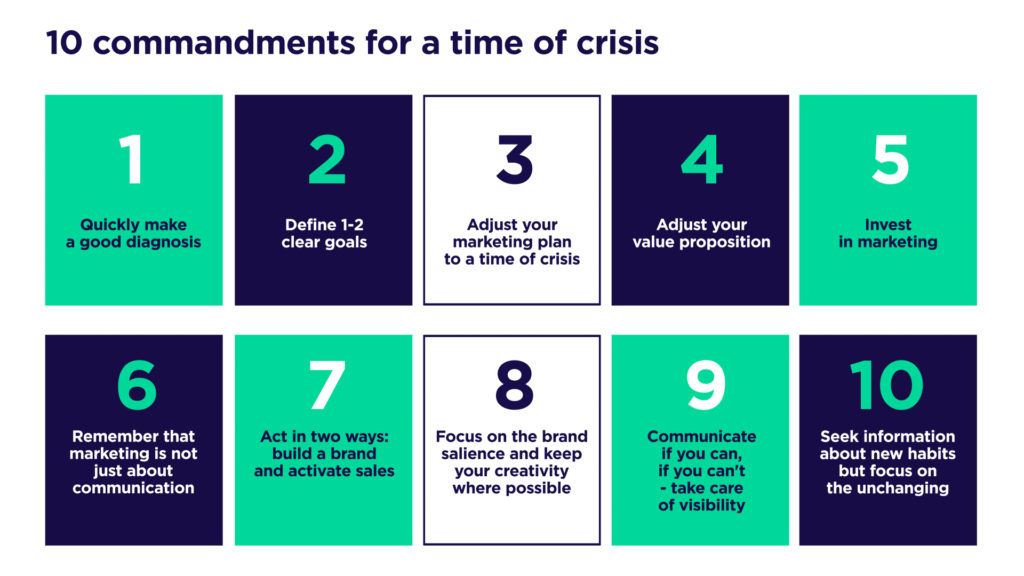“The only constant thing is change” – Heraclitus of Ephesus
Within the framework of another webinar conducted by Google under the common name of “Increase Awareness Academy” our partner decided to refresh the formula a little bit and instead of presenting a summary of trends in the search engine we had the opportunity to listen to Marta Jaskólska – CEO of Brand Logic, who talked about brand management in a crisis situation.
It is a truism to say that the current time of the pandemic is a time of crisis, perceived in different ways. However, as the speaker emphasized, it is important for a proper understanding of the current situation to see not only the virus, but also other important socio-political events that we have witnessed around the world in the recent past. All this leads to an increased sense of uncertainty both on the part of consumers and among marketers.
In response to this state of anxiety, two basic strategies can often be seen in marketing activities:
- The first one focuses on waiting – that is, it focuses on calming marketing activities down to a calmer period
- The second one focuses on budget allocation for short term pro-selling shares
Both strategies may seem justified at first sight, but they are not optimal ways to behave in a situation of uncertainty in the market. Such an approach, according to the speaker, is to build strategies on what remains unchanged, even though the times are very volatile. What are these unchangeable elements? Here the answer is provided by psychology: striving for survival, achieving success, loving, taking care of one’s needs.
The process of creating a strategy described by the expert as best practice focuses on three steps:
Diagnosis – Strategy – Tactics
Interestingly, these three steps are the same as building a strategy in times of greater stability. Why? The environment changes, the conditions in which we operate change, but the methodology is universal. Additionally, such a method of work, if the analysis stage is repeated cyclically, will allow us to avoid long-term use of already inadequate means (e.g. due to the change of crisis stage).
The stage of Diagnosis should, on the one hand, focus on the analysis of events, looking for analogies from the past, good patterns related to it, but also the place of our brand on the market and how the answers how the current situation will affect our position on it in the future. For example, if we are a manufacturer of toilet paper, we are short term winners – in the first stage of the crisis this is an essential product. Here, of course, we are helped by the classic four square box, which allows us to easily determine our position on the market in this context.
If the stage of diagnosis is behind us, we know where we are as a brand, we know what the needs of our customers are, we can move on to the stage of the Strategy – that is to define the basic plan of action, define business objectives and time periods for their implementation.
The next stage that comes out of the strategy stage is Tactics, which is the stage popularly called 4P (product, price, place, promotion).
In times of crisis, the “product” of these 4Ps seems to be particularly crucial if there are things in our portfolio that are not necessary or do not respond to basic needs, it may turn out that in times of uncertainty, our consumers will give up our services completely and we will have to face the possibility of a complete business collapse. Then it seems appropriate to redefine or rebuild your portfolio to better suit the situation.
So let’s first answer the question which of our products we want to promote as appropriate at the moment, and then let’s consider how we will communicate this and where. Here, however, we have to make sure that our message will be different from that of the rest of the market. The beginning of the pandemic was a period of very similar communication of many brands, which for many recipients was identical and merged into one.
Many brands at this stage went well beyond their existing portfolio of services, some of them to a lesser extent (Nike presented sets of exercises to be done at home), others fundamentally changed the range of services provided (an event company that started to provide online childcare services), but the common denominator was still to meet the new users’ needs in a manner appropriate to the situation.
In the words of the speakers, a time of crisis is a time of opportunity for brands that will not stop communicating adequately, based on an updated strategy, to their users. To support this thesis, BrandZ well-known research conducted after the crisis in 2008 was presented. According to their results, 1/3 of marketers reduce expenses and 2/3 increase them. Among those who increase them 60% increase them by 10% on average, the remaining 40% increases them by 49% on average. What are the effects of these actions? Those companies that ceased to communicate lost 0.1% of the market share on average and those that maintained communication gained 0.5% of the market share on average.
Finally, Marta Jaskólska reminded that
building a brand is a long-term process and therefore our actions cannot be based solely on emotions.
She emphasized the importance of the Diagnosis point, which allows us to give context to current events and verify the current portfolio of activities and products.
Only companies that have decided to take courageous steps and change the model of their actions in the face of the crisis could pass through this stage of the crisis.
Such a company is, for example, Lego, which at the end of the 90s was struggling with great difficulties. It was only the impressive expansion of the portfolio, for example by entering into cooperation with StarWars brand, that allowed Lego not only to regain its former position but also to strengthen it.
The whole presentation concluded with a Decalogue for the time of crisis, which codified the theses of the speakers and coherently linked the entire webinar.

Not all industry events are kept on a high level of merit, so Google and Ms. Marta Jaskólska deserve all the more applause for this meeting within the series.

